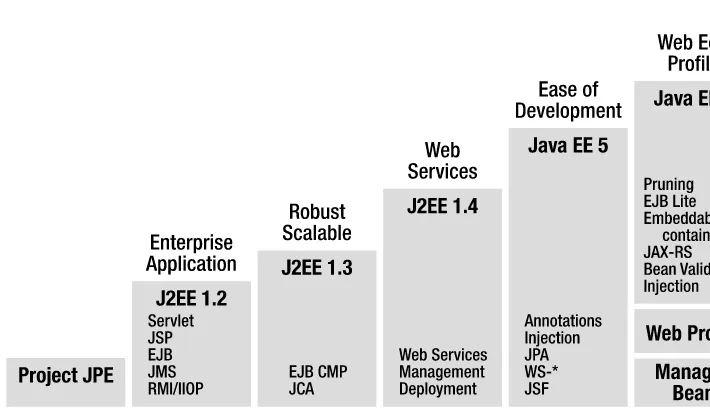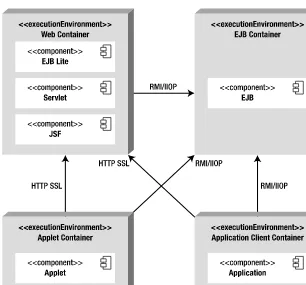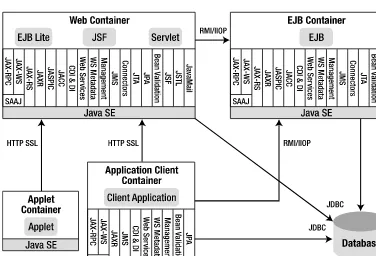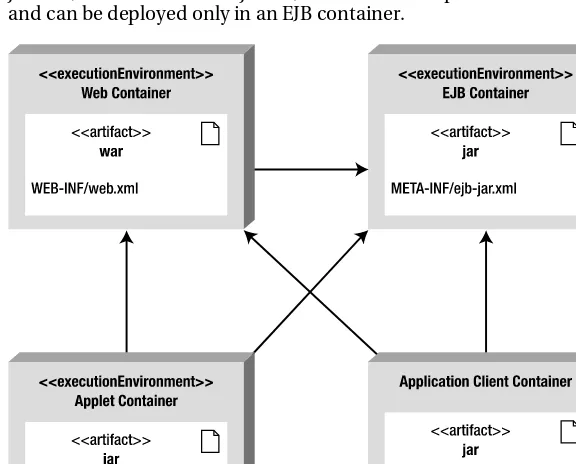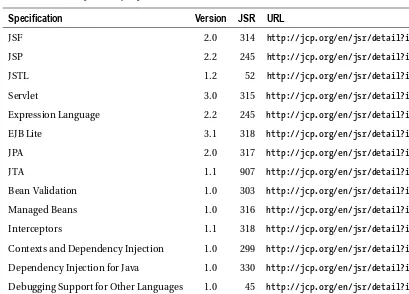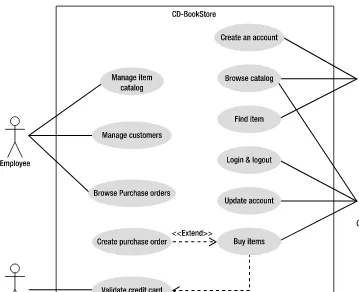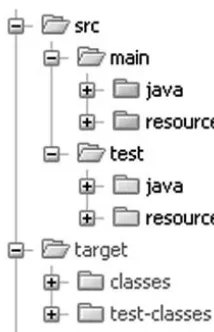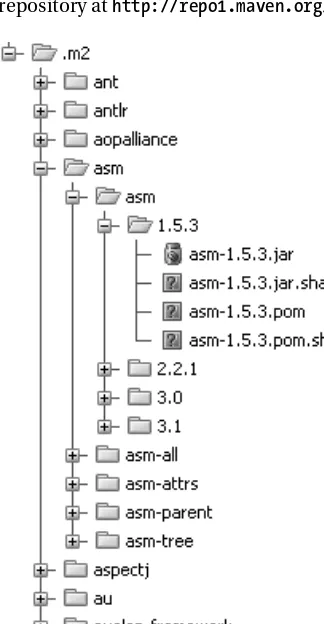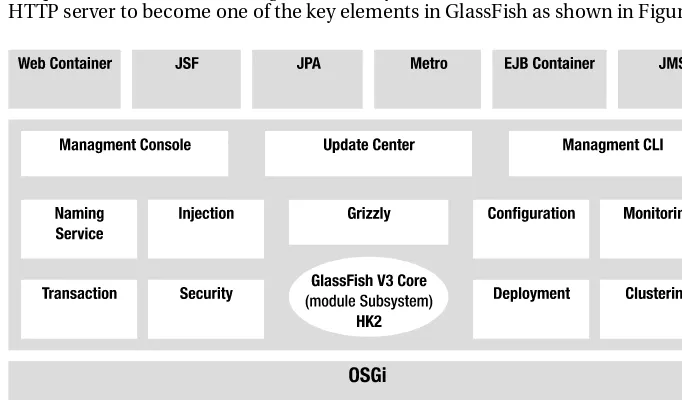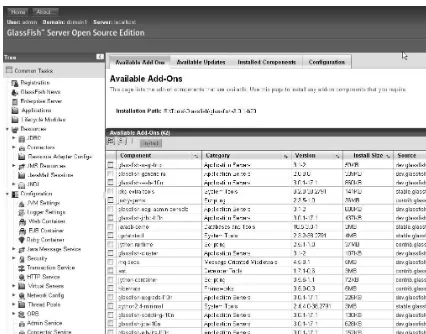Beginning
Java
™
EE 6
Platform
with
GlassFish
™
3
From Novice to Professional
SEcoNd EdITIoN
Antonio Goncalves
Expert member of the JSR-316 (Java
™EE 6),
JSR-317 (JPA 2.0), and JSR-318 (EJB
™3.1) groups
Step by step and easy to follow, this book describes
many of the Java
™EE 6 features, and shows them
in action using practical examples
SOURCE CODE ONLINE
Final Release
of Java
™EE 6
Platform
with GlassFish™ 3
Second Edition
■ ■ ■
All rights reserved. No part of this work may be reproduced or transmitted in any form or by any means, electronic or mechanical, including photocopying, recording, or by any information storage or retrieval system, without the prior written permission of the copyright owner and the publisher.
ISBN-13 (pbk): 978-1-4302-2889-9
ISBN-13 (electronic): 978-1-4302-2890-5
Printed and bound in the United States of America 9 8 7 6 5 4 3 2 1
Trademarked names, logos, and images may appear in this book. Rather than use a trademark symbol with every occurrence of a trademarked name, logo, or image we use the names, logos, and images only in an editorial fashion and to the benefit of the trademark owner, with no intention of infringement of the trademark.
The use in this publication of trade names, trademarks, service marks, and similar terms, even if they are not identified as such, is not to be taken as an expression of opinion as to whether or not they are subject to proprietary rights.
President and Publisher: Paul Manning Lead Editors: Steve Anglin, Tom Welsh Technical Reviewer: Jim Farley
Editorial Board: Clay Andres, Steve Anglin, Mark Beckner, Ewan Buckingham, Gary Cornell, Jonathan Gennick, Jonathan Hassell, Michelle Lowman, Matthew Moodie, Duncan Parkes, Jeffrey Pepper, Frank Pohlmann, Douglas Pundick, Ben Renow-Clarke, Dominic Shakeshaft, Matt Wade, Tom Welsh
Coordinating Editor: Mary Tobin Copy Editor: Ami Knox
Compositor: Kimberly Burton Indexer: Potomac Indexing, LLC Artist: April Milne
Cover Designer: Anna Ishchenko
Distributed to the book trade worldwide by Springer Science+Business Media, LLC., 233 Spring Street, 6th Floor, New York, NY 10013. Phone 1-800-SPRINGER, fax (201) 348-4505, e-mail
[email protected], or visit www.springeronline.com.
For information on translations, please e-mail [email protected], or visit www.apress.com.
Apress and friends of ED books may be purchased in bulk for academic, corporate, or promotional use. eBook versions and licenses are also available for most titles. For more information, reference our
Special Bulk Sales–eBook Licensing web page at www.apress.com/info/bulksales.
Contents at a Glance
■
Foreword ... xvii
■
About the Author ... xviii
■
About the Technical Reviewer ... xix
■
Acknowledgements ... xx
■
Preface ... xxi
■
Chapter 1: Java EE 6 at a Glance...1
■
Chapter 2: Java Persistence...43
■
Chapter 3: Object-Relational Mapping...61
■
Chapter 4: Managing Persistent Objects ...123
■
Chapter 5: Callbacks and Listeners ...167
■
Chapter 6: Enterprise Java Beans ...179
■
Chapter 7: Session Beans and the Timer Service...201
■
Chapter 8: Callbacks and Interceptors ...237
■
Chapter 9: Transactions and Security ...253
■
Chapter 10: JavaServer Faces...277
■
Chapter 11: Pages and Components...297
■
Chapter 12: Processing and Navigation ...345
■
Chapter 13: Sending Messages ...377
■
Chapter 14: SOAP Web Services ...415
■
Chapter 15: RESTful Web Services ...451
Contents
■
Foreword ... xvii
■
About the Author ... xviii
■
About the Technical Reviewer ... xix
■
Acknowledgements ... xx
■
Preface ... xxi
■
Chapter 1: Java EE 6 at a Glance...1
Understanding Java EE ...1
A Bit of History... 2
Standards ... 4
Architecture... 4
Java EE 6 Specifications... 10
What’s New in Java EE 6? ...12
Lighter ... 13
Easier to Use... 15
Richer ... 16
More Portable ... 18
The CD-BookStore Application...18
Setting Up Your Environment...20
JDK 1.6 ... 20
Maven 2... 21
JUnit 4 ... 27
Derby 10.6 ... 31
Summary ...41
■
Chapter 2: Java Persistence...43
JPA Specification Overview ...44
A Brief History of the Specification... 44
What’s New in JPA 2.0? ... 45
Reference Implementation ... 45
Understanding Entities...46
Object-Relational Mapping ... 46
Querying Entities ... 48
Callbacks and Listeners ... 49
Putting it all Together ...50
Writing the Book Entity ... 51
Writing the Main Class... 52
Persistence Unit for the Main Class... 53
Compiling with Maven ... 54
Running the Main Class with Derby... 56
Writing the BookTest Class... 57
Persistence Unit for the BookTest Class... 59
Running the BookTest Class with Embedded Derby... 60
Summary ...60
■
Chapter 3: Object-Relational Mapping...61
How to Map an Entity...61
Configuration by Exception... 63
Elementary Mapping...64
Tables ... 65
Primary Keys ... 68
Attributes ... 72
Collection of Basic Types... 81
Map of Basic Types ... 83
Mapping with XML ...84
Embeddables ...87
Access Type of an Embeddable Class ... 89
Relationship Mapping ...91
Relationships in Relational Databases ... 92
Entity Relationships ... 93
Fetching Relationships ... 105
Ordering Relationships ... 107
Inheritance Mapping ...110
Inheritance Strategies ... 110
Type of Classes in the Inheritance Hierarchy ... 118
Summary ...121
■
Chapter 4: Managing Persistent Objects ...123
How to Query an Entity ...123
Entity Manager...127
Obtaining an Entity Manager ... 128
Persistence Context... 130
Manipulating Entities... 132
Cache API ... 142
JPQL...145
Select... 146
From ... 148
Where ... 148
Order By... 150
Group By and Having ... 150
Bulk Update ... 151
Queries...151
Dynamic Queries ... 154
Named Queries ... 155
Native Queries ... 158
Criteria API (or Object-Oriented Queries)... 158
Concurrency...161
Versioning... 163
Optimistic Locking... 164
Pessimistic Locking... 166
Summary ...166
■
Chapter 5: Callbacks and Listeners ...167
Entity Life Cycle ...167
Callbacks ...169
Listeners ...172
Summary ...177
■
Chapter 6: Enterprise Java Beans ...179
Understanding EJBs...179
Types of EJBs ... 181
Anatomy of an EJB ... 181
EJB Container ... 183
Embedded Container ... 184
Dependency Injection and JNDI... 185
Callback Methods and Interceptors... 186
Packaging... 186
EJB Specification Overview ...187
History of the Specification ... 187
EJB Lite... 189
Reference Implementation ... 189
Putting It All Together ...190
Writing the Book Entity ... 191
Writing the BookEJB Stateless Session Bean... 191
Persistence Unit for the BookEJB ... 193
Writing the Main Class... 194
Compiling and Packaging with Maven ... 194
Deploying on GlassFish... 196
Running the Main Class with the Application Client Container... 197
Writing the BookEJBTest Class... 197
Summary ...199
■
Chapter 7: Session Beans and the Timer Service ...201
Session Beans ...201
Stateless Beans... 202
Stateful Beans ... 205
Singletons... 207
Session Bean Model ... 214
Asynchronous Calls ... 226
Embeddable Usage... 228
The Timer Service...230
Calendar-Based Expression... 231
Automatic Timer Creation... 233
Programmatic Timer Creation ... 234
Summary ...235
■
Chapter 8: Callbacks and Interceptors ...237
Session Beans Life Cycle...237
Stateful . ... 239
Callbacks . ... 240
Interceptors ...243
Around-Invoke Interceptors. ... 244
Method Interceptors . ... 247
Life-Cycle Interceptor . ... 249
Chaining and Excluding Interceptors. ... 250
Summary ...252
■
Chapter 9: Transactions and Security ...253
Transactions ...253
ACID . ... 254
Local Transactions. ... 254
Distributed Transactions and XA . ... 256
Transaction Support in EJB ...259
Container-Managed Transactions . ... 259
Bean-Managed Transactions. ... 266
Security...268
Principals and Roles . ... 268
Authentication and Authorization . ... 269
Security Support in EJB ...269
Declarative Security . ... 270
Programmatic Security. ... 273
Summary ...275
■
Chapter 10: JavaServer Faces...277
Understanding JSF...278
FacesServlet and faces-config.xml . ... 279
Pages and Components. ... 279
Converters and Validators ... 281
Managed Beans and Navigation ... 281
Ajax Support ... 282
Web Interface Specifications Overview ...282
A Brief History of Web Interfaces... 283
JSP 2.2, EL 2.2, and JSTL 1.2... 283
JSF 2.0... 283
What’s New in JSF 2.0... 284
Reference Implementation ... 284
Putting It All Together ...284
Writing the Book Entity ... 286
Writing the BookEJB... 286
Writing the BookController Managed Bean ... 287
Writing the newBook.xhtml Page ... 288
Writing the listBooks.xhtml Page... 290
Configuration with web.xml... 292
Compiling and Packaging with Maven ... 293
Deploying on GlassFish... 294
Running the Example... 294
Summary ...295
■
Chapter 11: Pages and Components...297
Web Pages ...297
HTML ... 297
XHTML ... 299
CSS ... 301
DOM... 303
JavaScript... 304
Java Server Pages ...306
Scripting Elements ... 308
Action Elements... 309
Putting It All Together... 310
Expression Language...312
JSP Standard Tag Library ...314
Core Actions ... 314
Formatting Actions ... 316
SQL Actions ... 317
XML Actions... 319
Functions ... 321
Facelets ...322
JavaServer Faces ...323
Life Cycle ... 324
Standard HTML Components ... 326
Resource Management... 336
Composite Components... 337
Implicit Objects... 342
Summary ...343
■
Chapter 12: Processing and Navigation ...345
The MVC Pattern ...345
FacesServlet... 346
FacesContext ... 349
Faces Config ... 350
Managed Beans ...351
How to Write a Managed Bean ... 351
Managed Bean Model... 352
Navigation... 356
Conversion and Validation ...363
Converters ... 363
Custom Converters ... 365
Validators... 366
Custom Validators... 367
Ajax ...368
General Concepts ... 368
Support in JSF ... 370
Putting It All Together... 372
Summary ...376
■
Chapter 13: Sending Messages ...377
Understanding Messages ...377
JMS ... 378
MDB ... 378
Messaging Specification Overview...379
A Brief History of Messaging ... 379
JMS 1.1 ... 379
EJB 3.1 ... 379
Reference Implementation ... 380
How to Send and Receive a Message...380
Java Messaging Service ...382
Point-to-Point ... 383
Publish-Subscribe ... 384
JMS API ... 385
Selectors... 397
Reliability Mechanisms... 397
Message-Driven Beans...400
MDB Model ... 401
MDB as a Consumer ... 405
MDB as a Producer... 406
Transaction... 407
Handling Exceptions ... 408
Putting It All Together ...409
Writing the OrderDTO... 409
Writing the OrderSender... 409
Writing the OrderMDB... 410
Compiling and Packaging with Maven ... 411
Creating the Administered Objects... 413
Deploying the MDB on GlassFish... 413
Running the Example... 414
Summary ...414
■
Chapter 14: SOAP Web Services ...415
Understanding SOAP Web Services ...415
XML... 416
WSDL ... 417
SOAP... 417
UDDI... 417
Transport Protocol ... 418
SOAP Web Services Specification Overview...418
A Brief History of SOAP Web Services ... 418
Java EE Specifications ... 418
Reference Implementation ... 420
How to Invoke a SOAP Web Service...420
Java Architecture for XML Binding ...422
Annotations... 425
The Invisible Part of the Iceberg ...428
WSDL ... 428
SOAP... 431
Java API for XML-Based Web Services...432
JAX-WS Model... 432
Invoking a SOAP Web Service ... 440
Putting It All Together ...442
Writing the CreditCard Class... 442
Writing the CardValidator SOAP Web Service... 442
Compiling and Packaging with Maven ... 443
Deploying on GlassFish... 444
Writing the Web Service Consumer... 446
Generating Consumer’s Artifacts and Packaging with Maven ... 447
Running the Main Class... 449
Summary ...450
■
Chapter 15: RESTful Web Services ...451
Understanding RESTful Web Services ...451
Resources and URIs... 451
Representations... 452
WADL ... 453
HTTP ... 453
RESTful Web Services Specification...458
A Brief History of REST ... 459
JAX-RS 1.1... 459
What’s New in JAX-RS 1.1?... 459
Reference Implementation ... 460
From the Web to Web Services ... 460
A Web-Browsing Experience ... 460
Uniform Interface... 461
Addressability... 461
Connectedness ... 462
Statelessness ... 463
Java API for RESTful Web Services...463
The JAX-RS Model... 464
How to Write a REST Service... 464
URI Definition... 465
Extracting Parameters ... 467
Consuming and Producing Content Types... 468
Entity Provider ... 471
Methods or the Uniform Interface... 473
Contextual Information ... 474
Exception Handling... 475
Life Cycle ... 476
Putting It All Together ...477
Writing the Book Entity ... 477
Writing the BookResource ... 478
Configuring Jersey... 481
Compiling and Packaging with Maven ... 481
Deploying on GlassFish... 482
Running the Example... 483
Summary ...484
Foreword
While Java EE 5 is considered by everyone to be the most important enterprise release, Java EE 6 has a lot in store for you and every server-side Java developer. The most widely spread technology to write enterprise-class applications just got better with enhanced EJB 3.1, Java Persistence API (JPA) 2.0, the new, yet already very successful, Java API for RESTful web services (JAX-RS), and the made-over
JavaServer Faces (JSF) 2.0 specification. The enterprise Java platform has now matured to a degree where it can be both complete and lightweight.
Now you could spend quality time with your favorite search engine and blog reader to navigate through the numerous blogs, wikis, and documentation covering all or parts of Java EE 6, but I’d like to suggest that you’d be better off starting with this book. It is concise, pragmatic, and offers an all-in-one experience.
Having the open source GlassFish application server as the underlying platform for this book makes a lot of sense for two reasons: first, GlassFish v3 is the Reference Implementation (RI) and thus is aligned with Java EE 6, and second, using an RI does not mean you can’t please developers and scale to
production deployments. The skills acquired with GlassFish in conjunction with those of the most recent technologies are portable in the enterprise.
Antonio Goncalves is a rare combination of friendly Java enthusiast and precise yet no-nonsense Java EE expert. His role as a consultant combined with his involvement chairing the successful Java User Group in Paris and, of course, his role as a member of several key Java EE 6 expert groups makes him the
ideal author for Beginning Java EE 6 Platform with GlassFish 3.
When you are done reading this book, I’d like to suggest that the greatest value of Java EE is not the sum of its features but rather the community that created it, as well as the very nature of it being a standard that lets you choose or change your implementation as you wish. Freedom is not simply about open source but also about open standards.
Alexis Moussine-Pouchkine
About the Author
■ Antonio Goncalves is a senior software architect living in Paris. Initially
focused on Java development since the late 1990s, his career has taken him to different countries and companies where he works now as a Java EE
consultant in software architecture. As a former BEA consultant, he has great expertise in application servers such as WebLogic, JBoss, and, of course, GlassFish. He is particularly fond of open source and is a member of the OSSGTP (Open Source Solution Get Together Paris). He is also the cocreator and coleader of the Paris Java User Group.
Antonio wrote his first book on Java EE 5, in French, back in 2007. Since then he has joined the JCP and is an Expert Member of various JSRs (Java EE 6, JPA 2.0, and EJB 3.1). For the last few years, Antonio has given talks at international conferences mainly about Java EE, including JavaOne, The Server Side Symposium, Devoxx, Jazoon and many Java User Groups. He has also written numerous technical papers and articles for IT web sites (DevX)
and IT magazines (Programmez, Linux Magazine). Since 2009, he has been
part of the French Java podcast called Les Cast Codeurs (influenced by the Java Posse). For all his work for the Java Community, Antonio has been elected Java Champion.
About the Technical Reviewer
Jim Farley is a technology architect, strategist, writer, and manager. His
Writing a book about a new specification such as Java EE 6 is an enormous task that requires the talent of different people. First of all, I really want to thank Steve Anglin from Apress for giving me the
opportunity to contribute to the Apress Beginning series, which I greatly appreciated as a reader.
Throughout the writing process, I was constantly in contact with Mary Tobin and Tom Welsh who reviewed the book as well as reassured me when I had doubt about finishing on time. Thanks to Jim Farley who did an excellent job of giving me good technical advice to improve the book.
I also need to thank Alexis Midon and Sebastien Auvray, who coauthored the RESTful web services chapter (Chapter 15). Alexis is a passionate software engineer and a REST enthusiast, and Sebastien is a talented developer and a pragmatic adopter of REST. Thanks, guys, for your precious help.
A special thanks to Alexis Moussine-Pouchkine, who kindly agreed to write the foreword of this book as well as the section on GlassFish. He was also a big help in contacting the right person to give me a hand on a particular topic. I’m thinking of Ryan Lubke for JSF 2.0, Paul Sandoz for JAX-RS 1.1, and François Orsini for Derby.
Thanks to Damien Gouyette for his help on JSF 2.0. Damien has great experience in web development as a whole and JSF in particular. Thanks to Arnaud Heritier, who wrote the section on Maven, as well as Nicolas de Loof, who did a last proofread on the topic.
Sebastien Moreno helped me on JUnit as well as reviewing the entire manuscript with David Dewalle and Pascal Graffion. They had to put up with a tight schedule. Thank you very much for the hard work.
Thanks to the proofreader Stefano Costa, who tried to add a Shakespearean touch to the book. The diagrams in this book were made using the Visual Paradigm plug-in for IntelliJ IDEA. I would like to thank both Visual Paradigm and JetBrains for providing me with a free license for their excellent products.
I could not have written this book without the help and support of the Java community: people who gave a bit of their time to help me through e-mails, mailing lists, or forums. Of course, the mailing lists of the JCP expert groups are the first that come to mind; thanks to the expert members and the spec leads (Roberto Chinnici, Bill Shannon, Kenneth Saks, Linda DeMichiel, Michael Keith, Reza Rahman, Adam Bien, etc.).
And a big kiss to my daughter Eloïse, who is growing up and such a wonderful loving kid. A book is conceived with the help of a never-ending list of people you want to thank for having contributed, in one way or another: technical advice, a beer at the bar, an idea, or a piece of code (Bernard Pons, Youness Teimoury, Mariane Hufschmitt, Jean-Louis Dewez, Frédéric Drouet, the Paris JUG geeks, the OSSGTP guys, Les Cast Codeurs, FIP, Marion, Les Connards, Vitalizen, La Fontaine, Ago, La Grille, les Eeckman, Yaya, Rita, os Navalhas, La Commune Libre d’Aligre, etc.).
Preface
In today’s business world, applications need to access data, apply business logic, add presentation layers, and communicate with external systems. That’s what companies are trying to achieve while minimizing costs, using standard and robust technologies that can handle heavy loads. If that’s your case, you have the right book in your hands.
Java Enterprise Edition appeared at the end of the 1990s and brought to the Java language a robust software platform for enterprise development. Challenged at each new version, badly understood or misused, overengineered, and competing with open source frameworks, J2EE was seen as a heavyweight technology. Java EE benefited from these criticisms to improve and is today focused on simplicity.
If you are part of the group of people who still think that “EJBs are bad, EJBs are evil,” read this book, and you’ll change your mind. EJBs (Enterprise Java Beans) are great, as is the entire Java EE 6 technology stack. If, on the contrary, you are a Java EE adopter, you will see in this book how the platform has found equilibrium, through its ease of development in all the stacks, new specifications, lighter EJB component model, profiles, and pruning. If you are a beginner in Java EE, this is also the right book: it covers the most important specifications in a very understandable manner and is illustrated with a lot of code and diagrams to make it easier to follow.
Open standards are collectively one of the main strengths of Java EE. More than ever, an application written with JPA, EJB, JSF, JMS, SOAP web services, or RESTful web services is portable across
application servers. Open source is another of Java EE’s strengths. As you’ll see in this book, most of the Java EE 6 Reference Implementations use open source licensing (GlassFish, EclipseLink, Mojarra, OpenMQ, Metro, and Jersey).
This book explores the innovations of this new version, and examines the various specifications and how to assemble them to develop applications. Java EE 6 consists of nearly 30 specifications and is an important milestone for the enterprise layer (EJB 3.1, JPA 2.0), for the web tier (Servlet 3.0, JSF 2.0), and for interoperability (SOAP web services and RESTful services). This book covers a broad part of the Java EE 6 specifications and uses the JDK 1.6 and some well-known design patterns, as well as the GlassFish application server, the Derby database, JUnit, and Maven. It is illustrated abundantly with UML diagrams, Java code, and screenshots.
How Is This Book Structured?
Chapter 1 briefly presents Java EE 6 essentials and the tools used throughout the book (JDK, Maven, JUnit, Derby, and GlassFish).
The persistent tier is described from Chapter 2 to Chapter 5 and focuses on JPA 2.0. After a general overview with some hands-on examples in Chapter 2, Chapter 3 dives into object-relational mapping (mapping attributes, relationships, and inheritance). Chapter 4 shows you how to manage and query entities, while Chapter 5 presents their life cycle, callback methods, and listeners.
To develop a transaction business logic layer with Java EE 6, you can naturally use EJBs. This will be described from Chapter 6 to Chapter 9. After an overview of the specification, its history, and a hands-on example in Chapter 6, Chapter 7 will concentrate on session beans and their programming model, as well as the new timer service. Chapter 8 focuses on the life cycle of EJBs and interceptors, while Chapter 9 explains transactions and security.
From Chapter 10 to Chapter 12, you will learn how to develop a presentation layer with JSF 2.0. After an overview of the specification in Chapter 10, Chapter 11 will focus on how to build a web page with JSF and Facelets components. Chapter 12 will show you how to interact with an EJB back end and navigate through pages.
Finally, the last chapters will present different ways to interoperate with other systems. Chapter 13 will show you how to exchange asynchronous messages with Java Message Service (JMS) and Message-Driven Beans (MDBs). Chapter 14 focuses on SOAP web services, while Chapter 15 covers RESTful web services.
Downloading and Running the Code
www.apress.com. You can also download the code straight from the public Subversion at
http://beginningee6.kenai.com.
Contacting the Author
If you have any questions about the content of this book, the code, or any other topic, please contact me at [email protected]. You can also visit my web site at www.antoniogoncalves.org and follow
■ ■ ■
Java EE 6 at a Glance
Enterprises today live in a global competitive world. They need applications to fulfill their business needs, which are getting more and more complex. In this age of globalization, companies are distributed over continents, they do business 24/7 over the Internet and across different countries, and their systems have to be internationalized and ready to deal with different currencies and time zones. All that while reducing their costs, lowering the response times of their services, storing business data on reliable and safe storage, and offering several graphical user interfaces to their customers, employees, and suppliers.
Most companies have to combine these innovative challenges with their existing Enterprise Information Systems (EIS) while at the same time developing business-to-business applications to communicate with partners. It is also not rare for a company to have to coordinate in-house data stored in different locations, processed by multiple programming languages, and routed through different protocols. And, of course, it has to do this without losing money, which means preventing system crashes and being highly available, scalable, and secure. Enterprise applications have to face change and complexity, and be robust. That’s precisely why Java Enterprise Edition (Java EE) was created.
The first version of Java EE (originally known as J2EE) focused on the concerns that companies were facing back in 1999: distributed components. Since then, software applications have had to adapt to new technical solutions like SOAP or RESTful web services. The platform has evolved to respond to these technical needs by providing various standard ways of working through specifications. Throughout the years, Java EE has changed and become richer, simpler, easier to use, and more portable.
In this chapter, I’ll give you an overview of Java EE. After an introduction of its internal architecture, I’ll cover what’s new in Java EE 6. The second part of this chapter focuses on setting up your
development environment so you can do some hands-on work by following the code snippets listed in these pages.
Understanding Java EE
Java EE 6 is an important milestone. Not only does it follow the steps of Java EE 5 by focusing on an easier development model, it also adds new specifications and brings profiles and pruning to make it lighter. The release of Java EE 6 coincides closely with the tenth anniversary of the enterprise platform. It combines the advantages of the Java language with experience gained over the last ten years. Moreover, it profits from the dynamism of open source communities as well as the rigor of the JCP. Today Java EE is a well-documented platform with experienced developers, a large community, and many deployed applications running on companies’ servers. Java EE is a suite of APIs to build standard component-based multitier applications. These components are deployed in different containers offering a series of services.
A Bit of History
Ten years is a good time to look back at the evolution of Java EE (see Figure 1-1), which was formerly called J2EE. J2EE 1.2, first developed by Sun, was released in 1999 as an umbrella specification containing ten Java Specification Requests (JSRs). At that time people were talking about CORBA, so J2EE 1.2 was created with distributed systems in mind. Enterprise Java Beans (EJBs) were introduced with support for remote stateful and stateless service objects, and optional support for persistent objects (entity beans). They were built on a transactional and distributed component model using RMI-IIOP (Remote Method Invocation–Internet Inter-ORB Protocol) as the underlying protocol. The web tier had servlets and JavaServer Pages (JSPs), and JMS was used for sending messages.
■
Note
CORBA originated about 1988 precisely because enterprise systems were beginning to be distributed
(e.g., Tuxedo, CICS). EJBs and then J2EE followed on with the same assumptions, but ten years later. By the time
J2EE was begun, CORBA was fully baked and industrial strength, but companies found simpler, more decoupled
ways to connect distributed systems, like web services. So CORBA became redundant for most enterprise
systems.
Starting with J2EE 1.3, the specification was developed by the Java Community Process (JCP) under JSR 58. Support for entity beans was made mandatory, and EJBs introduced XML deployment
descriptors to store metadata (which was serialized in a file in EJB 1.0). This version addressed the overhead of passing arguments by value with remote interfaces, by introducing local interfaces and passing arguments by reference. J2EE Connector Architecture (JCA) was introduced to connect Java EE to EIS.
■
Note
The JCP is an open organization, created in 1998, that is involved in the definition of future versions and
features of the Java platform. When the need for a new component or API is identified, the initiator (a.k.a.
specification lead) creates a JSR and forms a group of experts. This group, made of companies’ representatives,
organizations, universities or private individuals, is responsible for the development of the JSR and has to deliver
1) one or more specifications that explain the details and define the fundamentals of the JSR, 2) a Reference
Implementation (RI), which is an actual implementation of the specification, and 3) a Compatibility Test Kit (a.k.a.
Technology Compatibility Kit, or TCK), which is a set of tests every implementation needs to pass before claiming
to conform to the specification. Once approved by the Executive Committee (EC), the specification is released to
the community for implementation. Java EE is called an Umbrella JSR, or a Platform Edition Specification (such as
Profiles), because it ties together other JSRs.
J2EE 1.4 (JSR 151) included 20 specifications in 2003 and added support for web services. EJB 2.1 allowed session beans to be invoked over SOAP/HTTP. A timer service was created to allow EJBs to be invoked at designated times or intervals. This version provided better support for application assembly and deployment.
than an evolution of the platform. JavaServer Faces (JSF) was introduced as the standard presentation tier framework, and JAX-WS 2.0 replaced JAX-RPC as the SOAP web services API.
Today, Java EE 6 (JSR 316) follows the path of ease of development by embracing the concepts of annotations, POJO programming, and the configuration-by-exception mechanism throughout the platform, including the web tier. It comes with a rich set of innovations such as the brand-new JAX-RS 1.1; it simplifies mature APIs like EJB 3.1, and enriches others such as JPA 2.0 or the timer service. But the major themes for Java EE 6 are portability (through standardizing global JNDI naming, for example), deprecation of some specifications (via pruning), and creating subsets of the platform through profiles. In this book, I want to show you these improvements and how much easier and richer Java Enterprise Edition has become.
Standards
As you can see, Java EE is based on standards. It is an umbrella specification that bundles together a number of other JSRs. You might ask why standards are so important, as some of the most successful Java frameworks are not standardized (Struts, Spring, etc.). Throughout history, humans have created standards to ease communication and exchange. Some notable examples are language, currency, time, navigation, measurements, tools, railways, electricity, telegraphs, telephones, protocols, and
programming languages.
In the early days of Java, if you were doing any kind of web or enterprise development, you were living in a proprietary world by creating your own frameworks or locking yourself to a proprietary commercial framework. Then came the days of open source frameworks, which are not always based on open standards. You can use open source and be locked to a single implementation, or use open source that implements standards and be portable. Java EE provides open standards that are implemented by several commercial (WebLogic, Websphere, MQSeries, etc.) or open source (GlassFish, JBoss, Hibernate, Open JPA, Jersey, etc.) frameworks for handling transactions, security, stateful components, object persistence, and so on. Today, more than ever in the history of Java EE, your application is deployable to any compliant application server with very few changes.
Architecture
Java EE is a set of specifications implemented by different containers. Containers are Java EE runtime environments that provide certain services to the components they host such as life-cycle management, dependency injection, and so on. These components use well-defined contracts to communicate with the Java EE infrastructure and with the other components. They need to be packaged in a standard way (following a defined directory structure that can be compressed, we talk about archive files) before being deployed. Java EE is a superset of the Java SE platform, which means Java SE APIs can be used by any Java EE components.
Figure 1-2. Standard Java EE containers
Components
The Java EE runtime environment defines four types of components that an implementation must support:
• Applets are GUI applications that are executed in a web browser. They use the rich
Swing API to provide powerful user interfaces.
• Applications are programs that are executed on a client. They are typically GUIs or
batch-processing programs that have access to all the facilities of the Java EE middle tier.
• Web applications (made of servlets, servlet filters, web event listeners, JSP pages,
• Enterprise applications (made of Enterprise Java Beans, Java Message Service, Java
Transaction API, asynchronous calls, timer service, RMI/IIOP) are executed in an EJB container. EJBs are container-managed components for processing
transactional business logic. They can be accessed locally and remotely through RMI (or HTTP for SOAP and RESTful web services).
Containers
The Java EE infrastructure is partitioned into logical domains called containers (see Figure 1-2). Each container has a specific role, supports a set of APIs, and offers services to components (security, database access, transaction handling, naming directory, resource injection). Containers hide technical complexity and enhance portability. Depending on the kind of application you want to build, you will have to understand the capabilities and constraints of each container in order to use one or more. For example, if you need to develop a web application, you will develop a JSF tier with an EJB Lite tier and deploy them into a web container. But if you want a web application to invoke a business tier remotely and use messaging and asynchronous calls, you will need both the web and EJB containers.
Applet containers are provided by most web browsers to execute applet components. When you develop applets, you can concentrate on the visual aspect of the application while the container gives you a secure environment. The applet container uses a sandbox security model where code executed in the “sandbox” is not allowed to “play outside the sandbox.” This means that the container prevents any code downloaded to your local computer from accessing local system resources, such as processes or files.
The application client container (ACC) includes a set of Java classes, libraries, and other files required to bring injection, security management, and naming service to Java SE applications (Swing,
batch processing, or just a class with a main() method). ACC communicates with the EJB container using
RMI-IIOP and the web container with HTTP (e.g., for web services).
The web container provides the underlying services for managing and executing web components (servlets, EJBs Lite, JSPs, filters, listeners, JSF pages, and web services). It is responsible for instantiating, initializing, and invoking servlets and supporting the HTTP and HTTPS protocols. It is the container used to feed web pages to client browsers.
The EJB container is responsible for managing the execution of the enterprise beans containing the business logic tier of your Java EE application. It creates new instances of EJBs, manages their life cycle, and provides services such as transaction, security, concurrency, distribution, naming service, or the possibility to be invoked asynchronously.
Services
Containers provide underlying services to their deployed components. As a developer, you can
concentrate on implementing business logic rather than solving technical problems faced in enterprise applications. Figure 1-3 shows you the services provided by each container. For example, web and EJB containers provide connectors to access EIS, but not the applet container or the ACCs. Java EE offers the following services:
• Java Transaction API (JTA): This service offers a transaction demarcation API used
• Java Persistence API (JPA): Standard API for object-relational mapping (ORM).
With its Java Persistence Query Language (JPQL), you can query objects stored in the underlying database.
• Validation: Bean Validation provides a class level constraint declaration and
validation facility.
• Java Message Service (JMS): This allows components to communicate
asynchronously through messages. It supports reliable point-to-point (P2P) messaging as well as the publish-subscribe (pub-sub) model.
• Java Naming and Directory Interface (JNDI): This API, included in Java SE, is used
to access naming and directory systems. Your application uses it to associate (bind) names to objects and then to find these objects (lookup) in a directory. You can look up datasources, JMS factories, EJBs, and other resources. Omnipresent in your code until J2EE 1.4, JNDI is used in a more transparent way through
injection.
• JavaMail: Many applications require the ability to send e-mails, which can be
implemented through use of the JavaMail API.
• JavaBeans Activation Framework (JAF): The JAF API, included in Java SE, provides
a framework for handling data in different MIME types. It is used by JavaMail.
• XML processing: Most Java EE components can be deployed with optional XML
deployment descriptors, and applications often have to manipulate XML documents. The Java API for XML Processing (JAXP) provides support for parsing documents with SAX and DOM APIs, as well as for XSLT. The Streaming API for XML (StAX) provides a pull-parsing API for XML.
• Java EE Connector Architecture (JCA): Connectors allow you to access EIS from a
Java EE component. These could be databases, mainframes, or Enterprise Resource Planning (ERP) programs.
• Security services: Java Authentication and Authorization Service (JAAS) enables
services to authenticate and enforce access controls upon users. The Java Authorization Service Provider Contract for Containers (JACC) defines a contract between a Java EE application server and an authorization service provider, allowing custom authorization service providers to be plugged into any Java EE product.
• Web services: Java EE provides support for SOAP and RESTful web services. The
Java API for XML Web Services (JAX-WS), replacing the Java API for XML-based RPC (JAX-RPC), provides support for web services using the SOAP/HTTP protocol. The Java API for RESTful Web Services (JAX-RS) provides support for web services using the REST style.
• Dependency injection: Since Java EE 5, some resources (datasources, JMS factories,
• Management: Java EE defines APIs for managing containers and servers using a
special management enterprise bean. The Java Management Extensions (JMX) API is also used to provide some management support.
• Deployment: The Java EE Deployment Specification defines a contract between
deployment tools and Java EE products to standardize application deployment.
Figure 1-3. Services provided by containers
Network Protocols
As shown in Figure 1-3 (see the “Platform Overview” section of the Java EE 6 specification), components deployed in containers can be invoked through different protocols. For example, a servlet deployed in a web container can be called with HTTP as well as a web service with an EJB endpoint deployed in an EJB container. Here is the list of protocols supported by Java EE:
• HTTP: HTTP is the Web protocol and is ubiquitous in modern applications. The
client-side API is defined by the java.net package in Java SE. The HTTP
• RMI-IIOP: Remote Method Invocation (RMI) allows you to invoke remote objects
independently of the underlying protocol. The Java SE native RMI protocol is Java Remote Method Protocol (JRMP). RMI-IIOP is an extension of RMI used to integrate with CORBA. Java interface description language (IDL) allows Java EE application components to invoke external CORBA objects using the IIOP protocol. CORBA objects can be written in many languages (Ada, C, C++, Cobol, etc.) as well as Java.
Packaging
To be deployed in a container, components have first to be packaged in a standard formatted archive. Java SE defines Java Archive (jar) files, which are used to aggregate many files (Java classes, deployment descriptors, resources, or external libraries) into one compressed file (based on the ZIP format). As seen in Figure 1-4, Java EE defines different types of modules that have their own packaging format based on this common jar format.
An application client module contains Java classes and other resource files packaged in a jar file. This jar file can be executed in a Java SE environment or in an application client container. Like any
other archive format, the jar file contains an optional META-INF directory for meta information describing
the archive. The META-INF/MANIFEST.MF file is used to define extension- and package-related data. If
deployed in an ACC, the deployment descriptor can optionally be located at
META-INF/application-client.xml.
An EJB module contains one or more session and/or message-driven beans (MDBs) packaged in a
jar file (often called an EJB jar file). It contains an optional META-INF/ejb-jar.xml deployment descriptor
and can be deployed only in an EJB container.
A web application module contains servlets, JSPs, JSF pages, and web services, as well as any other web-related files (HTML and XHTML pages, Cascading Style Sheets (CSS), Java-Scripts, images, videos, and so on). Since Java EE 6, a web application module can also contain EJB Lite beans (a subset of the
EJB API described in Chapter 6). All these artifacts are packaged in a jar file with a .war extension
(commonly referred to as a war file, or a Web Archive). The optional web deployment descriptor is
defined in the WEB-INF/web.xml file. If the war contains EJB Lite beans, an optional deployment
descriptor can be set at WEB-INF/ejb-jar.xml. Java.class files are placed under the WEB-INF/classes
directory and dependent jar files in the WEB-INF/lib directory.
An enterprise module can contain zero or more web application modules, zero or more EJB modules, and other common or external libraries. All this is packaged into an enterprise archive (a jar
file with an .ear extension) so that the deployment of these various modules happens simultaneously
and coherently. The optional enterprise module deployment descriptor is defined in the
META-INF/application.xml file. The special lib directory is used to share common libraries between the modules.
Java Standard Edition
It’s important to stress that Java EE is a superset of Java SE (Java Standard Edition). This means that all the features of the Java language are available in Java EE as well as the APIs.
Java SE 6 was officially released on December 11, 2006. It was developed under JSR 270 and brought many new features as well as continuing the ease of development introduced by Java SE 5 (autoboxing, annotations, generics, enumeration, etc.). Java SE 6 provides new tools for diagnosing, managing, and monitoring applications. It improves the existing JMX API and simplifies execution of scripting
languages in the Java Virtual Machine (JVM). This book does not explicitly cover Java SE 6, so you should refer to the extensive Java literature available if you are not comfortable with it. A good starting point
would be Beginning Java™ SE 6 Platform: From Novice to Professional by Jeff Friesen (Apress, 2007).
Java EE 6 Specifications
Java EE 6 is an umbrella specification defined by JSR 316 that contains 33 other specifications. An application server that aims to be Java EE 6 compliant has to implement all these specifications. Tables 1-1 to 1-5 list them all, grouped by technological domain, with their version and JSR numbers. Some specifications have been pruned, which means that they will possibly be removed from Java EE 7.
Table 1-1. Java Enterprise Edition Specification
Specification
Version JSR URL
Java EE 6.0 316 http://jcp.org/en/jsr/detail?id=316
Web Profile 6.0 316 http://jcp.org/en/jsr/detail?id=316
Table 1-2. Web Services Specifications
Specification Version
JSR
URL
Pruned
JAX-RPC 1.1 101 http://jcp.org/en/jsr/detail?id=101 X
JAX-WS 2.2 224 http://jcp.org/en/jsr/detail?id=224
JAXB 2.2 222 http://jcp.org/en/jsr/detail?id=222
JAXM 1.0 67 http://jcp.org/en/jsr/detail?id=67
StAX 1.0 173 http://jcp.org/en/jsr/detail?id=173
Web Services 1.2 109 http://jcp.org/en/jsr/detail?id=109
Web Services Metadata 1.1 181 http://jcp.org/en/jsr/detail?id=181
JAX-RS 1.1 311 http://jcp.org/en/jsr/detail?id=311
JAXR 1.1 93 http://jcp.org/en/jsr/detail?id=93 X
Table 1-3. Web Specifications
Specification Version
JSR
URL
Pruned
JSF 2.0 314 http://jcp.org/en/jsr/detail?id=314
JSP 2.2 245 http://jcp.org/en/jsr/detail?id=245
Debugging Support for Other Languages
1.0 45 http://jcp.org/en/jsr/detail?id=45
JSTL (JavaServer Pages Standard Tag Library)
1.2 52 http://jcp.org/en/jsr/detail?id=52
Servlet 3.0 315 http://jcp.org/en/jsr/detail?id=315
Table 1-4. Enterprise Specifications
Specification Version JSR URL
Pruned
EJB 3.1 318 http://jcp.org/en/jsr/detail?id=318 Entity CMP
Interceptors 1.1 318 http://jcp.org/en/jsr/detail?id=318
JAF 1.1 925 http://jcp.org/en/jsr/detail?id=925
JavaMail 1.4 919 http://jcp.org/en/jsr/detail?id=919
JCA 1.6 322 http://jcp.org/en/jsr/detail?id=322
JMS 1.1 914 http://jcp.org/en/jsr/detail?id=914
JPA 2.0 317 http://jcp.org/en/jsr/detail?id=317
JTA 1.1 907 http://jcp.org/en/jsr/detail?id=907
Table 1-5. Management, Security, and Other Specifications
Specification Version
JSR
URL
Pruned
JACC 1.1 115 http://jcp.org/en/jsr/detail?id=115
Bean Validation 1.0 303 http://jcp.org/en/jsr/detail?id=303
Contexts and Dependency Injection
1.0 299 http://jcp.org/en/jsr/detail?id=299
Dependency Injection for Java 1.0 330 http://jcp.org/en/jsr/detail?id=330
Common Annotations 1.1 250 http://jcp.org/en/jsr/detail?id=250
Java EE Application Deployment 1.2 88 http://jcp.org/en/jsr/detail?id=88 X
Java EE Management 1.1 77 http://jcp.org/en/jsr/detail?id=77
Java Authentication Service Provider Interface for Containers
1.0 196 http://jcp.org/en/jsr/detail?id=196
What’s New in Java EE 6?
Now that you’ve seen the internal architecture of Java EE, you might be wondering what the novelties are in Java EE 6. The main goal of this release is to continue the improved ease of development introduced with Java EE 5. In Java EE 5, EJBs, persistent entities, and web services were remodeled to follow a more object-oriented approach (Java classes implementing Java interfaces) and to use
EE 6 follows this path and applies the same paradigms to the web tier. Today, a JSF managed bean is an annotated Java class with an optional XML descriptor.
Java EE 6 focuses also on bringing simplicity to the platform by introducing profiles, and pruning some outdated technologies. It adds more features to the existing specification (e.g., standardizing singleton session beans) while adding new ones (such as JAX-RS). More than before, Java EE 6 applications are portable across containers with standard JNDI names and a specified embedded EJB container.
Lighter
The Java EE 6 expert group had to face an interesting challenge: how to make the platform lighter while adding more specifications? Today, an application server has to implement 33 specifications in order to be compliant with Java EE 6. A developer has to know thousands of APIs, some not even relevant anymore because they are being pruned. To make the platform more lightweight, the group introduced profiles, pruning, and EJB Lite (a subset of the full EJB features focusing on local interfaces, interceptors, transactions, and security only). EJB Lite is explained in greater detail in Chapter 6.
Pruning
Java EE was first released in 1999, and ever since new specifications have been added at each release (as shown previously in Figure 1-1). This became a problem in terms of size, implementation, and adoption. Some features were not well supported or not widely deployed because they were technologically outdated or other alternatives were made available in the meantime. So the expert group decided to propose the removal of some features through pruning.
Java EE 6 has adopted the pruning process (also known as marked for deletion) already adopted by the Java SE group. It consists of proposing a list of features for possible removal in Java EE 7. Note that none of the proposed removal items will actually be removed from Java EE 6 but could be from Java EE 7. Some features will be replaced by newer specifications (such as entity beans being replaced by JPA), and others will just leave the Java EE 7 umbrella and keep on evolving as individual JSRs (e.g., JSR 88). Here is the list of pruned features:
• EJB 2.x Entity Beans CMP (part of JSR 318): The complex and heavyweight
persistent component model of EJB 2.x entity beans has been replaced by JPA.
• JAX-RPC (JSR 101): This was the first attempt to model SOAP web services as RPC
calls. It has now been replaced by the much easier to use and robust JAX-WS.
• JAXR (JSR 93): JAXR is the API dedicated to communicating with UDDI registries.
Because UDDI is not widely used, JAXR would leave Java EE and evolve as a separate JSR.
• Java EE Application Deployment (JSR 88): JSR 88 is a specification that tool
Profiles
Profiles are a major new feature in the Java EE 6 environment. Their main goal is to reduce the size of the platform to suit the developer’s needs more efficiently. No matter the size or complexity of the
application you develop today, you will deploy it in an application server that offers you APIs and services for 33 specifications. A major criticism leveled against Java EE was that it was too large. Profiles are designed precisely to address this issue. As shown in Figure 1-5, profiles are subsets of the platform or supersets of it, and may overlap with the platform or with other profiles.
Figure 1-5. Profiles in the Java EE platform
Table 1-6. Web Profile 1.0 Specifications
Specification
Version JSR URL
JSF 2.0 314 http://jcp.org/en/jsr/detail?id=314
JSP 2.2 245 http://jcp.org/en/jsr/detail?id=245
JSTL 1.2 52 http://jcp.org/en/jsr/detail?id=52
Servlet 3.0 315 http://jcp.org/en/jsr/detail?id=315
Expression Language 2.2 245 http://jcp.org/en/jsr/detail?id=245
EJB Lite 3.1 318 http://jcp.org/en/jsr/detail?id=318
JPA 2.0 317 http://jcp.org/en/jsr/detail?id=317
JTA 1.1 907 http://jcp.org/en/jsr/detail?id=907
Bean Validation 1.0 303 http://jcp.org/en/jsr/detail?id=303
Managed Beans 1.0 316 http://jcp.org/en/jsr/detail?id=316
Interceptors 1.1 318 http://jcp.org/en/jsr/detail?id=318
Contexts and Dependency Injection 1.0 299 http://jcp.org/en/jsr/detail?id=299
Dependency Injection for Java 1.0 330 http://jcp.org/en/jsr/detail?id=330
Debugging Support for Other Languages 1.0 45 http://jcp.org/en/jsr/detail?id=45
Common Annotations 1.1 250 http://jcp.org/en/jsr/detail?id=250
Easier to Use
Besides making the platform lighter, one aim of Java EE 6 was also to make it easier to use. A direction taken by this version was to apply the ease-of-use paradigm to the web tier. Java EE components need metadata to instruct the container about components’ behavior. Before Java EE 5, the only format you could use for metadata was XML (in deployment descriptor file). Since Java EE 5, you can also use annotations directly in your code. With less XML to write, components would be easier to package and deploy. In Java EE 5, the enterprise tier was rearchitected, and the components moved toward POJOs and interfaces. But the web tier didn’t benefit from these improvements.
Today in Java EE 6, servlets, JSF managed beans, JSF converters, validators, and renderers are also annotated classes with optional XML deployment descriptors. Listing 1-1 shows a JSF managed bean that turns out to be a Java class with a single annotation. If you are already familiar with JSF, you will be
pleased to know that, in most cases, the faces-config.xml file faces-config.xml file becomes optional
Listing 1-1. A JSF Managed Bean
private List<Book> bookList = new ArrayList<Book>(); public String doCreateBook() {
EJBs also become easier to develop in Java EE 6. As shown in Listing 1-2, if you need to access an EJB locally, a simple annotated class with no interface is enough. EJBs can also be deployed directly in a war file without being previously packaged in a jar file. This makes EJBs the simplest transactional
component that can be used from simple web applications to complex enterprise ones.
Listing 1-2. A Stateless EJB
@Stateless
public class BookEJB {
@PersistenceContext(unitName = "chapter01PU") private EntityManager em;
On one hand, Java EE 6 is becoming lighter by introducing profiles, and on the other it’s also becoming richer by adding new specifications and improving existing ones. RESTful web services have been making their way into modern applications. Java EE 6 follows the needs of enterprises by adding the new
JAX-RS specification. As shown in Listing 1-3, a RESTful web service is an annotated Java class that responds to HTTP actions. You will learn more about JAX-RS in Chapter 15.
Listing 1-3. A RESTful Web Service
@Path("books")
public class BookResource {
@PersistenceContext(unitName = "chapter01PU") private EntityManager em;
@GET
@Produces({"application/xml", "application/json"}) public List<Book> getAllBooks() {
Query query = em.createNamedQuery("findAllBooks"); List<Book> books = query.getResultList();
return books; }
}
The new version of the persistence API (JPA 2.0) is improved by adding collections of simple data
types (String, Integer, etc.), pessimistic locking, a richer JPQL syntax, a brand-new Criteria API, and
support for a caching API. JPA is discussed in Chapter 2 through Chapter 5.
EJBs are easier to develop (with optional interfaces) and to package (in a war file), but they also have new features, such as the possibility to use asynchronous calls or a richer timer service for scheduling tasks. There is also a new singleton session bean component. As shown in Listing 1-4, a single
annotation can turn a Java class into a container-managed singleton (one instance of the component per application). You will learn more about these new features in Chapter 6 through Chapter 9.
Listing 1-4. A Singleton Session Bean
@Singleton
public class CacheEJB {
private Map<Long, Object> cache = new HashMap<Long, Object>(); public void addToCache(Long id, Object object) {
if (!cache.containsKey(id)) cache.put(id, object); }
public Object getFromCache(Long id) { if (cache.containsKey(id)) return cache.get(id); else
return null; }
The presentation tier also gets richer. JSF 2.0 adds support for Ajax and for Facelets (see Chapter 10 through Chapter 12).
More Portable
From its creation, the aim of Java EE was to enable the development of an application and its deployment to any application server without changing the code or the configuration files. This was never as easy as it seemed. Specifications don’t cover all the details, and implementations end up providing nonportable solutions. That’s what happened with JNDI names, for example. If you deployed an EJB to GlassFish, JBoss, or WebLogic, the JNDI name was different because it wasn’t part of the specification, so you had to change your code depending on the application server you used. That particular problem has now been fixed, because Java EE 6 specifies a syntax for JNDI names that is the same across application servers (see Chapter 7).
Another difficult point with EJBs was the ability to test them, or use them in a Java SE environment. Some application servers (such as JBoss) had specific implementations to do it. EJB 3.1 specifies an embedded container that is a standard API for executing EJBs within a Java SE environment (see Chapter 7).
The CD-BookStore Application
Figure 1-6. Use case diagram of the CD-BookStore application
The actors interacting with the system described in Figure 1-6 are:
• Employees of the company who need to manage both the catalog of items and the
customers’ details. They can also browse the purchase orders.
• Users who are anonymous persons visiting the web site and consulting the catalog
of books and CDs. If they want to buy an item, they need to create an account to become customers.
• Customers who can browse the catalog, update their account details, and buy
items online.
• The external bank to which the system delegates credit card validations.
Setting Up Your Environment
This book shows you lots of code, and most of the chapters have a “Putting It All Together” section. These sections provide step-by-step examples showing you how to develop, compile, deploy, execute, and unit test a component. To run these examples, you need to install the required software:
• JDK 1.6
• Maven 2
• JUnit 4
• Derby 10.6 database (a.k.a. Java DB)
• GlassFish v3.0.1 application server
JDK 1.6
Essential for the development and the execution of the examples in the book is the Java Development Kit
(JDK). It includes several tools such as a compiler (javac), a virtual machine, a documentation generator
(javadoc), monitoring tools (Visual VM), and so on. To install the JDK 1.6, go to the official Sun web site (http://java.sun.com/javase/downloads), select the appropriate platform and language, and download the distribution.
If you are running on Windows (Linux and OS X are not supported in this book but the code should
be portable), double-click the jdk-6u20-windows-i586.exe file. The first screen invites you to accept the
license of the software, and then the second screen, shown in Figure 1-7, lists the modules of the JDK you can choose to install (JDK, JRE, Derby database, sources).
Once the installation is complete, it is necessary to set the JAVA_HOME variable and the
%JAVA_HOME%\bin directory to the PATH variable. Check that Java is recognized by your system by entering
java –version (see Figure 1-8).
Figure 1-8. Displaying the JDK version
Maven 2
To reflect what you’ll find in the real development world, I’ve decided to use Apache Maven
(http://maven.apache.org) to build the examples of this book. The purpose of this book is not to explain Maven. You will find plenty of resources for Maven on the Internet or in bookstores. But I will introduce some elements so that you can easily understand and use the examples.
A Bit of History
Building a Java EE application requires different operations:
• Generating code and resources
• Compiling Java classes and test classes
• Packaging the code in an archive (jar, ear, war, etc.) with potentially external jar
libraries
Doing these tasks manually can be time-consuming and can generate errors. Thus, development teams have looked for ways of automating these tasks.
In 2000, Java developers started to use Apache Ant (http://ant.apache.org), allowing them to create
scripts for building applications. Ant itself is written in Java and offers a range of commands that, unlike a Unix Make tool, are portable across platforms. Development teams started to create their own scripts to fulfill their needs. Yet Ant was quickly pushed to its limits when projects had to start encompassing complex heterogeneous systems. Companies faced difficulties to industrialize their build system. There was no real tool to easily reuse a build script between different projects (copy/paste was the only way).
Figure 1-9. Standard Maven directory structure
Project Descriptor
Maven is based on the fact that a majority of Java and Java EE projects face similar needs when building applications. A Maven project needs to follow standards as well as define specific features in a project
descriptor, or Project Object Model (POM). The POM is an XML file (pom.xml) placed at the root of the
project. As shown in Listing 1-5, the minimum required information to describe the identity of the
project is the groupId, the artifactId, the version, and the packaging type.
Listing 1-5. Minimal pom.xml
<?xml version="1.0" encoding="UTF-8"?>
<project xmlns="http://maven.apache.org/POM/4.0.0"
xmlns:xsi="http://www.w3.org/2001/XMLSchema-instance"
xsi:schemaLocation="http://maven.apache.org/POM/4.0.0
http://maven.apache.org/xsd/maven-4.0.0.xsd"> <modelVersion>4.0.0</modelVersion>
<groupId>com.apress.javaee6</groupId> <artifactId>chapter01</artifactId> <version>2.0-SNAPSHOT</version> <packaging>jar</packaging> </project>
A project is often divided into different artifacts. These artifacts are then grouped under the same
groupId (similar to packages in Java) and uniquely identified by the artifactId. Packaging allows Maven to produce the artifact following a standard format (jar, war, ear, etc.). Finally, the version allows identifying an artifact during its lifetime (version 1.1, 1.2, 1.2.1, etc.). Maven imposes versioning so a
